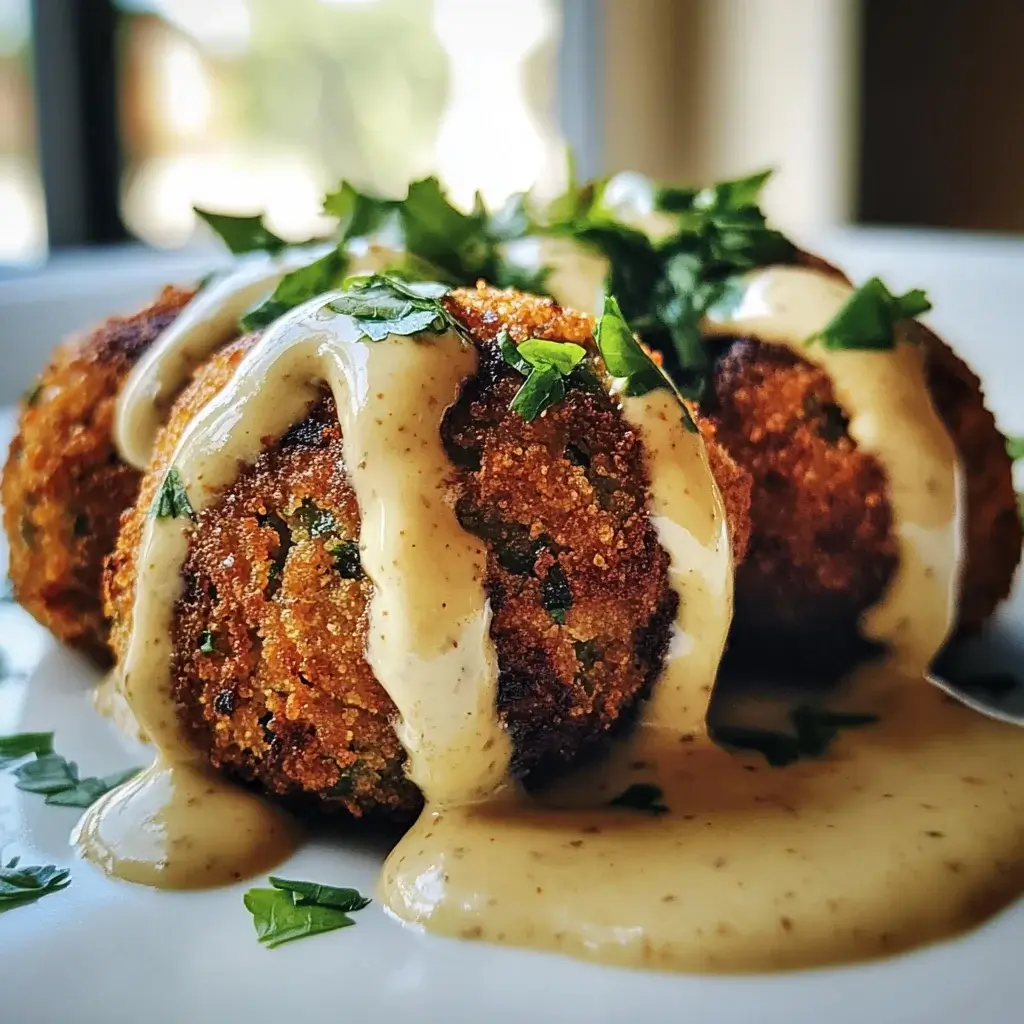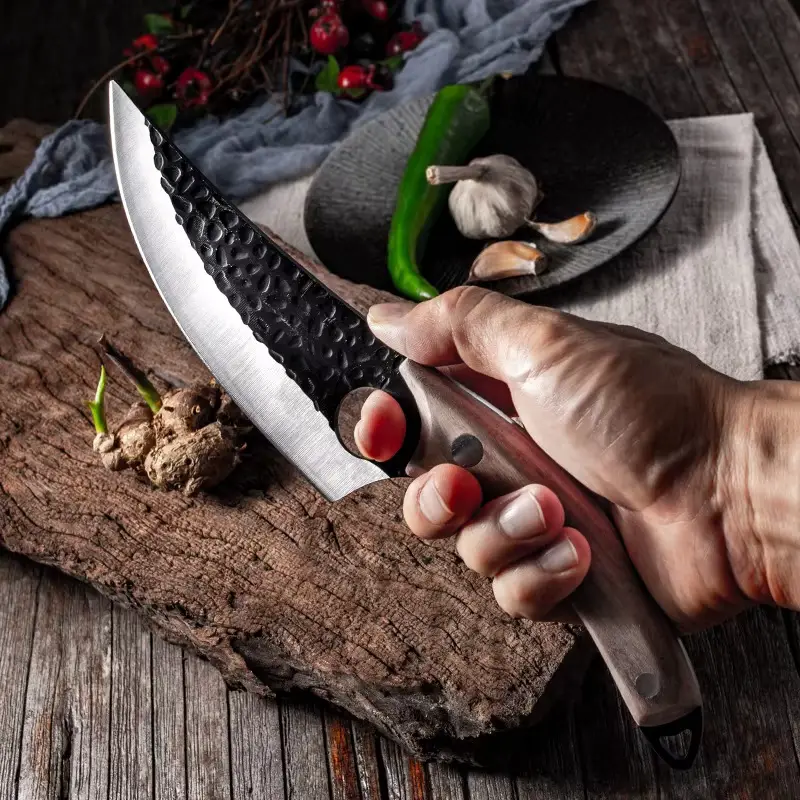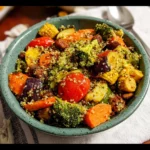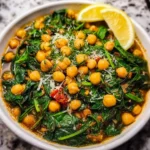Falafel balls are a beloved dish in our household, often making an appearance in our weekly meal rotations. The crispy exterior paired with the soft, flavorful interior is a treat for the senses. When paired with a rich, creamy tahini sauce, it becomes a dish that is hard to resist. My family, ranging from picky eaters to adventurous ones, all find something to love about these little balls of goodness. The versatility of falafel allows for creativity in serving, whether in a wrap, atop a salad, or simply as a snack with sauce on the side. Each bite is a delightful blend of spices and textures, making it a favorite comfort food that also feels wholesome and nourishing.
Ingredients
The beauty of falafel lies in its simplicity and the use of humble ingredients that come together to create something extraordinary. Here is what you will need:
- 1 cup dried chickpeas, soaked overnight
- 1 small onion, chopped
- 2 cloves garlic, minced
- 1/4 cup fresh parsley, chopped
- 1/4 cup fresh cilantro, chopped
- 1 teaspoon ground cumin
- 1 teaspoon ground coriander
- 1/2 teaspoon salt
- 1/2 teaspoon baking powder
- 3 tablespoons all-purpose flour
- Vegetable oil for frying
- For the tahini sauce:
- 1/2 cup tahini
- 2 tablespoons lemon juice
- 1 clove garlic, minced
- 1/4 cup water (adjust for desired consistency)
- Salt to taste
Instructions
Falafel is a dish that has been cherished for centuries, and the process of making it at home can be as rewarding as it is delicious. Follow these steps:
- Prepare the chickpeas: Drain and rinse the soaked chickpeas. Using a food processor, pulse the chickpeas until they are finely ground but not pureed.
- Combine ingredients: Add the onion, garlic, parsley, cilantro, cumin, coriander, salt, baking powder, and flour to the food processor. Pulse until the mixture is well combined but still has some texture.
- Shape the falafel: Transfer the mixture to a bowl and let it rest for about 30 minutes in the refrigerator. This helps the mixture firm up and makes shaping easier. After resting, use your hands to form small balls or patties, about 1.5 inches in diameter.
- Fry the falafel: In a deep skillet or pot, heat about 2 inches of vegetable oil to 350°F (175°C). Carefully drop the falafel balls into the oil, a few at a time, and fry until golden brown and crispy, about 3-4 minutes per side. Remove with a slotted spoon and drain on paper towels.
- Make the tahini sauce: In a small bowl, whisk together the tahini, lemon juice, garlic, and water until smooth. Adjust the consistency with more water if needed, and season with salt to taste.
Nutrition Facts
This falafel recipe serves approximately 4 people, with each serving containing around 250 calories. This estimate includes both the falafel and the tahini sauce, ensuring you have a delicious yet balanced meal to enjoy.
Preparation Time
From start to finish, preparing these falafel balls with tahini sauce will take you about 1 hour and 15 minutes. This includes soaking time for the chickpeas, preparation, and cooking time. While the process is straightforward, the result is well worth the effort.
How to Serve Falafel
Falafel is not only a delicious and nutritious dish, but it also offers incredible versatility in how it can be served. With its crisp exterior and fluffy interior, falafel can complement a wide array of ingredients, making it a favorite among food enthusiasts worldwide. Below are some delightful serving suggestions that enhance the experience of enjoying falafel.
1. Classic Falafel Sandwich
One of the most beloved ways to serve falafel is in a warm pita bread, creating a classic falafel sandwich. Begin by warming the pita in a dry skillet or the oven to enhance its softness and flavor. Once warmed, fill the pita with a generous portion of crispy falafel balls. Add fresh, crisp lettuce for a satisfying crunch, juicy tomatoes for sweetness, and tangy pickles for an added punch. You can also include sliced cucumbers and red onions for extra freshness. To elevate the flavors, drizzle tahini sauce or a spicy harissa sauce inside the pita before topping it with the vegetables. This combination not only makes for a hearty meal but also showcases the delightful textures and flavors of falafel.
2. Falafel Salad Bowl
For a lighter, yet equally filling option, consider topping a vibrant salad with falafel balls. Start with a base of leafy greens such as spinach, arugula, or romaine lettuce. Then, add a colorful mix of vegetables such as cherry tomatoes, cucumbers, bell peppers, and shredded carrots. Place several falafel balls on top for a protein-packed addition that transforms an ordinary salad into a satisfying meal. To enhance the dish further, drizzle your favorite dressing, such as a lemon-tahini dressing or a zesty vinaigrette, over the salad. This option not only keeps the meal healthy but also allows for creativity in using seasonal vegetables.
3. Appetizer with Tahini Sauce
Falafel makes for an excellent appetizer, especially when served with a side of creamy tahini sauce for dipping. Arrange the falafel balls on a platter, accompanied by a small bowl of tahini sauce. To make the sauce, simply blend tahini with lemon juice, garlic, and water until you achieve a smooth, pourable consistency. You can also add a pinch of cumin or paprika for added flavor. This serving style is perfect for gatherings and parties, allowing guests to enjoy falafel as finger food. Pair the falafel with crunchy vegetable sticks like carrots, celery, and bell peppers for a refreshing contrast.
4. Falafel Platter
Create a stunning falafel platter that showcases a variety of Middle Eastern dips and salads. Start with a generous serving of falafel balls at the center, surrounded by vibrant dips like hummus, tabbouleh, and baba ganoush. To prepare hummus, blend together chickpeas, tahini, lemon juice, garlic, and olive oil until smooth. Tabbouleh, a refreshing parsley salad, can be made with finely chopped parsley, mint, tomatoes, and bulgur, dressed with olive oil and lemon juice. Baba ganoush, a smoky eggplant dip, can be made by roasting eggplants and blending them with tahini, garlic, and lemon juice. This platter not only offers a variety of flavors and textures but also encourages sharing and socializing, making it an ideal choice for family meals or gatherings.
5. Falafel Wraps
For a portable and convenient meal, consider using falafel as a filling for wraps. Start with a large flatbread, such as lavash or a tortilla, and layer it with grilled vegetables like zucchini, bell peppers, and eggplant, which add a smoky flavor and complementary texture. Add a few falafel balls on top and finish with a drizzle of tahini sauce for extra moisture and flavor. You can also include fresh herbs like cilantro or parsley for an aromatic touch. Roll the wrap tightly and slice it in half for easy handling. This option is perfect for lunch on the go or a casual dinner.
Conclusion
Falafel’s versatility makes it an excellent choice for any meal occasion, whether you’re looking for a quick snack, a light lunch, or a hearty dinner. The various serving suggestions not only enhance its flavors but also allow for creative expression in the kitchen. Whether you enjoy it in a sandwich, salad, or platter, falafel is sure to satisfy your taste buds while offering a nutritious boost to your diet. Explore these serving ideas and discover your favorite way to enjoy this beloved dish!
Additional Tips for Perfect Falafel
Crafting the perfect falafel requires attention to detail and a few expert tips to ensure your results are consistently delicious. Below, we delve into some essential strategies to elevate your falafel-making skills and guarantee a delightful culinary experience with each batch.
1. Use Dried Chickpeas
One of the most critical factors in achieving the ideal falafel texture is the choice of chickpeas. While canned chickpeas are convenient, they often contain added moisture and can lead to a falafel mixture that is too wet, resulting in soggy patties that fall apart during frying. Instead, opt for dried chickpeas.
Preparation Tips:
- Soaking: Begin by soaking your dried chickpeas in ample water overnight (or for at least 8 hours). This not only softens the chickpeas but also helps them absorb water, ensuring they blend smoothly into a cohesive mixture.
- Rinsing: After soaking, rinse the chickpeas under cold water to remove any impurities and excess starch before processing.
2. Adjust the Texture
Getting the right consistency for your falafel mixture is crucial. The texture should be moist enough to hold together but not so wet that it becomes unmanageable.
Texture Troubleshooting:
- Too Wet: If your falafel mixture feels overly wet, it can lead to patties that won’t hold their shape. To remedy this, gradually add more flour (all-purpose or chickpea flour) in small increments until the desired consistency is achieved. The flour acts as a binding agent, helping to absorb excess moisture.
- Too Dry: Conversely, if the mixture is too dry and crumbly, adding a small amount of water (one teaspoon at a time) can bring it back to life. Alternatively, incorporating a bit of olive oil can enhance the flavor and moisture content.
3. Test Fry
Before committing to frying the entire batch, it’s wise to perform a test fry with a small portion of the mixture. This step allows you to check both the mixture’s consistency and the oil temperature.
Test Frying Steps:
- Heat a small amount of oil in a frying pan over medium heat.
- Shape a small ball of the falafel mixture and gently place it in the hot oil.
- Fry for about 2-3 minutes on each side until golden brown. This test will help you determine whether the mixture holds together and if adjustments need to be made, such as adding more flour or liquid.
4. Herb Variations
Falafel is a versatile dish that can be enhanced with a variety of herbs and spices. Traditional recipes often call for parsley and cilantro, but feel free to experiment with other herbs to create unique flavor profiles.
Herb Ideas:
- Dill: Adds a fresh, slightly tangy flavor that can elevate your falafel.
- Mint: Offers a refreshing twist, making your falafel perfect for summer dishes or as a complement to yogurt-based sauces.
- Basil or Oregano: Infuse Italian flavors by incorporating these herbs for a Mediterranean-inspired falafel.
5. Oven-Baked Option
For those seeking a healthier alternative to traditional frying, baking falafel is an excellent option that still delivers on taste and texture.
Baking Instructions:
- Preheat your oven to 375°F (190°C).
- Shape the falafel mixture into patties or balls and place them on a baking sheet lined with parchment paper. For better results, lightly brush or spray the falafel with olive oil to promote browning.
- Bake for 25-30 minutes, flipping them halfway through for even cooking. The falafel should be golden brown and crispy on the outside while remaining moist inside.
Benefits of Baking: Baking reduces the amount of oil used, making the falafel lower in calories and fat while still maintaining a delicious flavor. This method also allows for a more hands-off cooking approach, freeing you up to prepare accompanying dishes or sauces.
By implementing these additional tips, you can refine your falafel-making process and enjoy a consistently delightful dish that impresses family and friends alike. Whether you choose to fry or bake, remember that the key to great falafel lies in the quality of your ingredients and the attention you give to texture and flavor!
FAQ Section
- Can I freeze falafel?Yes, you can freeze falafel. It’s best to freeze them before frying. Simply shape the balls, place them on a baking sheet to freeze, then transfer to a freezer bag. Fry directly from frozen when ready to use.
- What can I substitute for chickpeas?If you’re out of chickpeas or want to try something different, you can use fava beans or a combination of fava beans and chickpeas for a different flavor profile.
- How do I keep falafel from falling apart?Ensuring the mixture is not too wet is key. Proper binding with flour and resting the mixture in the refrigerator can help the falafel hold together when frying.
- Is falafel gluten-free?Traditional falafel contains flour, but you can make a gluten-free version by using chickpea flour or another gluten-free flour as a binder.
- Can I make falafel without a food processor?Yes, you can make falafel without a food processor by using a potato masher or fork to mash the ingredients, though it will require more effort to achieve the desired texture.






